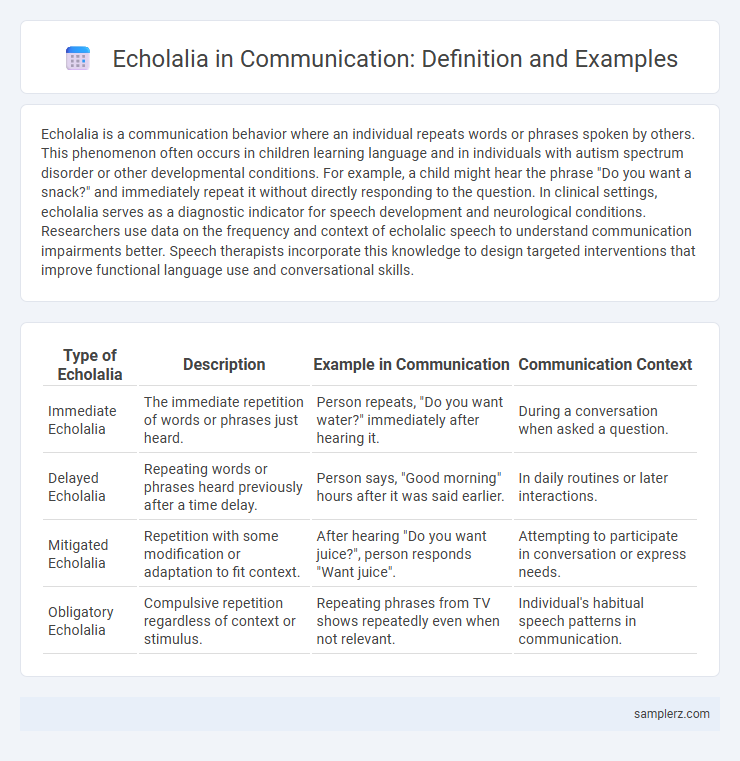Echolalia is a communication behavior where an individual repeats words or phrases spoken by others. This phenomenon often occurs in children learning language and in individuals with autism spectrum disorder or other developmental conditions. For example, a child might hear the phrase "Do you want a snack?" and immediately repeat it without directly responding to the question. In clinical settings, echolalia serves as a diagnostic indicator for speech development and neurological conditions. Researchers use data on the frequency and context of echolalic speech to understand communication impairments better. Speech therapists incorporate this knowledge to design targeted interventions that improve functional language use and conversational skills.
Table of Comparison
| Type of Echolalia | Description | Example in Communication | Communication Context |
|---|---|---|---|
| Immediate Echolalia | The immediate repetition of words or phrases just heard. | Person repeats, "Do you want water?" immediately after hearing it. | During a conversation when asked a question. |
| Delayed Echolalia | Repeating words or phrases heard previously after a time delay. | Person says, "Good morning" hours after it was said earlier. | In daily routines or later interactions. |
| Mitigated Echolalia | Repetition with some modification or adaptation to fit context. | After hearing "Do you want juice?", person responds "Want juice". | Attempting to participate in conversation or express needs. |
| Obligatory Echolalia | Compulsive repetition regardless of context or stimulus. | Repeating phrases from TV shows repeatedly even when not relevant. | Individual's habitual speech patterns in communication. |
Understanding Echolalia in Everyday Communication
Echolalia, the repetition of words or phrases spoken by others, commonly appears in developmental stages or certain neurodivergent conditions such as autism spectrum disorder. This automatic mirroring serves as a crucial communicative tool, aiding language acquisition and social interaction by reinforcing meaning and context. Recognizing echolalia in everyday communication helps caregivers and educators support language development and improve conversational engagement.
Common Examples of Echolalia in Conversation
Common examples of echolalia in conversation include repeated phrases or sentences immediately after hearing them, often used as a way to process or mimic speech. Children with autism spectrum disorder frequently echo questions before answering, while some individuals may repeat television dialogues or commonly heard expressions. This repetitive speech pattern can serve communication functions such as requesting, affirming, or self-soothing.
Echolalia in Children: Communication Scenarios
Echolalia in children often appears as immediate or delayed repetition of words or phrases heard in conversations or media, serving as a key communication behavior during language development. For example, a child may repeat a question like "Do you want juice?" even without intending to answer, using it as a bridge to build understanding and social interaction. This repetition can indicate processing of language patterns and plays a significant role in children with autism spectrum disorder, helping caregivers and therapists tailor effective communication strategies.
Echolalia and Social Interaction: Practical Illustrations
Echolalia manifests in social interactions when individuals, often children with autism spectrum disorder, repeat phrases or sentences spoken by others, aiding language development and social engagement. For example, a child might echo a question like "Do you want a toy?" before learning to respond independently, indicating an attempt to participate in conversation. This repetition helps bridge communication gaps, enabling gradual acquisition of conversational skills and enhancing social connection.
Echolalic Responses in Educational Settings
Echolalic responses in educational settings often manifest when students repeat phrases or questions posed by teachers, reflecting an attempt to process language and participate in communication. This behavior is commonly observed in children with autism spectrum disorder (ASD) and serves as a developmental strategy for language acquisition and social interaction. Understanding echolalia helps educators tailor communication techniques to support language development and engagement in the classroom.
Real-Life Dialogues Exhibiting Echolalia
In real-life dialogues, echolalia often appears when individuals with autism repeat phrases or questions spoken by others, such as a child mirroring a caregiver's "Do you want water?" before answering. This repetition serves communicative functions like requesting, affirming, or processing language, highlighting its role beyond mere imitation. Observing echolalia in conversations provides insight into the cognitive and social mechanisms underlying language development and communication strategies.
Echolalia in Autism: Communication Examples
Echolalia in autism often manifests as the immediate or delayed repetition of words or phrases heard in conversation, serving as a functional communication strategy. For example, a child with autism might repeat questions asked by a teacher or echo lines from a favorite television show to express needs or engage socially. This repetitive speech pattern supports language development and helps individuals with autism process and participate in social interactions more effectively.
Immediate vs. Delayed Echolalia: Communication Patterns
Immediate echolalia involves the instant repetition of words or phrases just heard, commonly observed in early language development or autism spectrum disorders, serving as a mechanism for language processing and interaction. Delayed echolalia occurs when phrases from previous conversations or media are repeated after a time gap, often functioning as a self-regulatory or communicative strategy. Differentiating these patterns is crucial for tailoring effective therapeutic communication interventions and understanding the underlying cognitive processes.
Echolalia in Adult Communication: Sample Situations
Echolalia in adult communication often appears in clinical settings, such as during conversations with individuals diagnosed with autism spectrum disorder or Tourette syndrome, where they may repetitively echo words or phrases heard moments earlier. In everyday interactions, adults might unintentionally mimic phrases heard in media or from others, reflecting a form of echolalia linked to social learning or anxiety responses. These sample situations highlight how echolalia serves as a communicative tool or coping mechanism, revealing underlying neurological or psychological conditions.
Functional Uses of Echolalia in Verbal Exchange
Echolalia serves functional purposes in verbal communication, such as aiding language acquisition by allowing individuals to imitate and practice speech patterns. It facilitates social interaction by enabling speakers to confirm understanding or request clarification through repetition. Moreover, echolalia can be used to regulate conversations, manage turn-taking, and reinforce messages within communicative exchanges.

example of echolalia in communication Infographic
 samplerz.com
samplerz.com